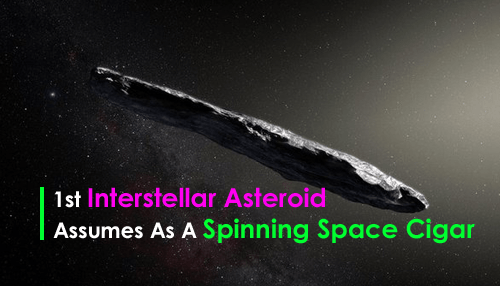

Exactly when space specialists using the Pan-STARRS1 telescope in Hawaii perceived a mysterious object dashing through our solar system on Oct. 19, they knew it was something phenomenal. Going at it quickly and originating from interstellar space, this challenge was at first thought to be an ancient comet, yet recognitions revealed it was, frankly, an asteroid from another star system.
“For a significantly long time, we’ve guessed that such interstellar articles are out there, and now—all of a sudden—we have organized affirmation they exist,” Thomas Zurbuchen, associate administrator for NASA’s Science Mission Directorate at the agency’s headquarters in Washington, D.C., said in a statement.
“This history-making discovery is opening a new window to study the formation of solar systems beyond our own,” he added.
Space specialists have affirmed that the perplexing thing—which has been named ‘Oumuamua and given the official scientific designation 1I/2017 U1—hovered around the sun on Sept. 9 and made its closest pass by Earth on Oct. 14. ‘Oumuamua (whose name implies “a messenger from afar arriving first” in Hawaiian) is as of now around 124 million miles (200 million kilometers) from Earth and is zooming a long way from us at around 85,700 mph (137,900 km/h) regarding the sun, NASA specialists said.
Agents mixed to get some great looks at the interstellar intruder, which has uncovered that this contradiction is unimaginably extraordinary. Unmistakably, it would seem that nothing we’ve ever observed has started late.
“It’s a truly exceptional request,” stargazer Ralf Kotulla, of the University of Wisconsin-Madison, said in a different statement.
With colleagues from UCLA and the National Optical Astronomy Observatory (NOAO), Kotulla’s gathering got a bit of the essential pictures of U1 using the 11.5-foot (3.5 meters) WIYN Telescope on Kitt Peak in Arizona. These first pictures confirmed that the object doesn’t have a coma—the cloud of dust and gas that rises from a comet as it approaches the sun and is thusly an irregularly shaped asteroid.
By and by, in an examination circulated on Nov. 20 in the journal Nature, space specialists using the European Southern Observatory’s (ESO) Very Large Telescope (VLT) in Chile portray the unusual properties of U1.
The VLT’s FORS instrument could make a great degree of correct spectroscopic estimations of ‘Oumuamua’s brightness and color. By joining the VLT observations with those made by various telescopes, space specialists found that ‘Oumuamua’s brightness changes by a factor of 10 as it spins on its axis every 7.3 hours.
It is informed by the astronomer Karen Meech of the Institute for Astronomy in Hawaii that “this unusually large variation in brightness means that the object is highly elongated: about 10 times as long as it is wide, with a complex, convoluted shape,” and she said in another sentence that “we also found that it has a dark red color, similar to objects in the outer solar system, and confirmed that it is completely inert, without the faintest hint of dust around it.”
‘Oumuamua is accepted to be no less than 1,300 feet (400 m) long, rocky (with some metal possibly mixed in), for the most part thick, and formed like a cigar, researchers said. It likely obtained its ruddy hue in the wake of being bombarded by high-energy cosmic rays for the considerable number of years it’s been gliding through interstellar space, team members added.
Using the NASA/European Space Agency Hubble Space Telescope and NASA’s Spitzer space telescope, cosmologists continue contemplating ‘Oumuamua as it moves toward the outer solar system, attempting to take in additional information about this strange object.
“We are continuing to watch this unique object, and we want to more unequivocally tie where it started from and where it is going next on its voyage through the universe,” observation team member Olivier Hainaut, from ESO in Garching, Germany, said in the ESO clarification. “Furthermore, now that we have found the principal interstellar rock, we are getting ready for the next ones!”
Astronomers estimate that such interstellar visitors shoot into the inner solar system about once every year, but only recently, with the staggeringly skilled optics of telescopes like Pan-STARRS1, have they had the ability to distinguish these very faint objects.
When investors start following the share market, two names often stand out: Nifty and Sensex. These indices are used every…
The demands of a career can often be overwhelming. Professionals juggle long work hours, deadlines, and a long list of…
Displaced children represent education's most urgent frontier, with studies showing refugee youth are five times less likely to attend school…
Modern businesses are creating and accumulating large amounts of data from multiple sources. While this data, along with AI and…
Navigating Florida Trucks: Key Regulations Every Truck Driver Must Know Florida's highways might be lined with palm trees, but for…
Gambling on the Internet is not just entertainment, but a complex experience, where every detail affects the player's satisfaction. Choosing…